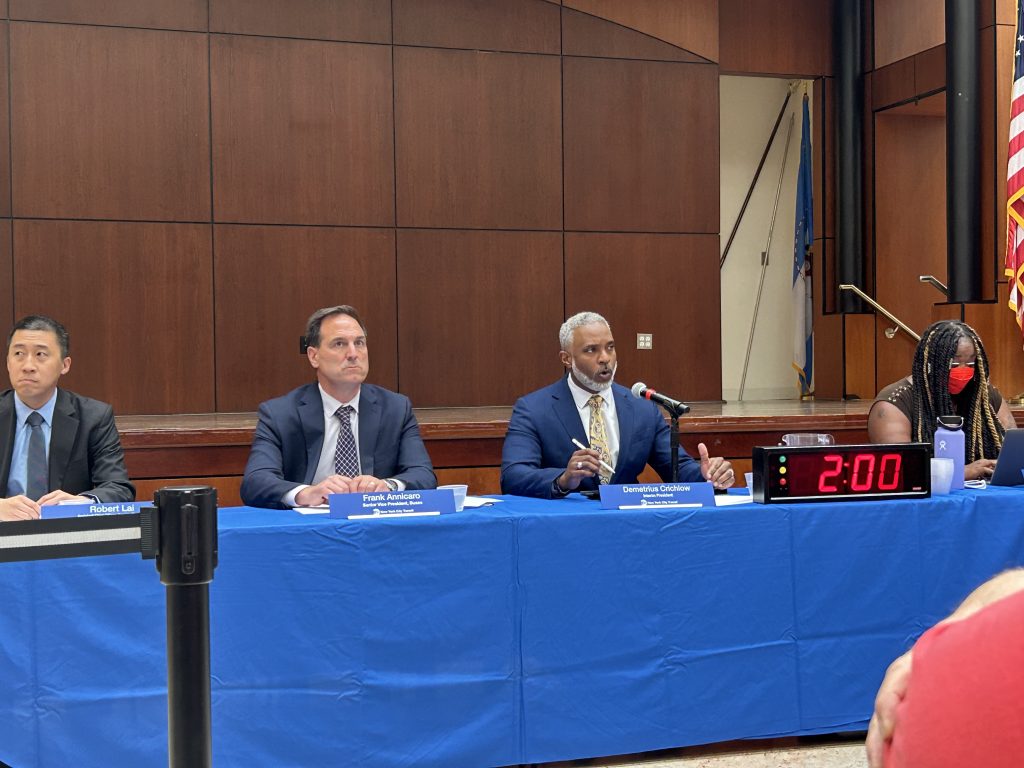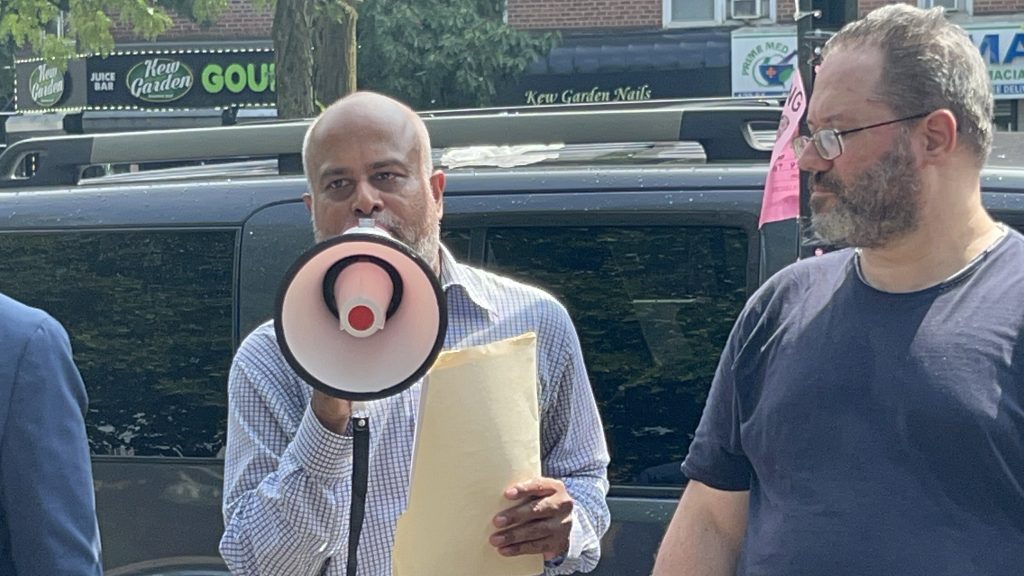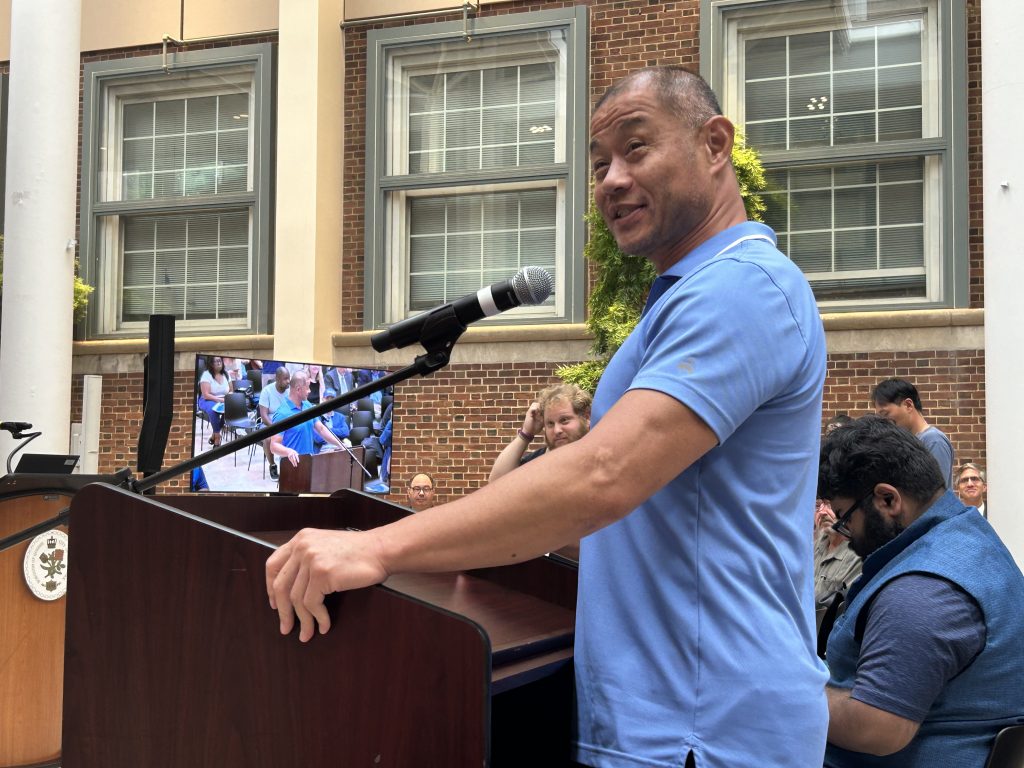by Marcus Ramos | news@queendsledger.com

Interim MTA President Demetrius Crichlow, Senior Vice President Frank Annicaro, and Assistant Chief Officer for Service and Operations Planning Robert Lai at Queens Bus Redesign hearing. Photo by Marcus Ramos.
The MTA held a hearing on July 24 for their Queens Bus Network Redesign, where Queens residents spoke to MTA staff, including president Demetrius Crichlow, directly to voice their opinions on the project. The hearing took place in Queens Borough Hall, where 150 New Yorkers spoke on the bus redesign, either in person or via Zoom.
The Queens Bus Redesign is the first borough-wide bus redesign in Queens in 60 years. First revealed to the public three years ago, the plan has faced pushback from Queens residents in the past, who worried the redesign would reduce the bus’s accessibility. This led to the plan undergoing multiple changes, with the current iteration being proposed as the final draft. The redesign aims to improve travel speed, reliability, and connectivity. The plan includes 121 bus routes, an increase from the current 113, new route types called “Rush” routes that connect outer neighborhoods to major transit hubs with fewer stops, and improved connections between bus routes and other transit options like the subway.
After presenting this final draft, the MTA held the public hearing to gauge how Queens residents feel about this new iteration. Despite the changes made to better serve users of the Queens bus network, the majority of those who spoke at the hearing still had grievances with the plan. One of the most vocal detractors was the Passengers United organization, which held their own rally in front of Queens Borough Hall hours before the MTA hearing.
Passengers United President Charlton D’souza took to a megaphone and outlined flaws with the bus network redesign.
“If you really want to do a bus redesign, you add more bus service,” D’souza said. “You make it easier. You add more buses, add more drivers, add more routes, that’s what should be done.”

Passengers United President Charlton D’souza holding rally hours before the public hearing. Photo by Marcus Ramos.
Passengers United also voiced their frustration during the hearing, presenting their concerns directly to the MTA. D’souza criticized the plan as unequal.
“Equity was not even considered in this redesign,” D’souza said. “You guys promised us a final plan before you implemented this but you changed the game on us, and now you’re saying you’ll release the final plan after this hearing. That is absurd. Go ahead, release your plan and implement this, we will sue you in civil court.”
Speaking alongside Passengers United was candidate for City Council District 28, Jonathan Rinaldi, who was vocal in his opposition to the redesign plan, claiming that the MTA is not acting in the interests of Queens residents.
“The MTA is an independent body, it’s not public,” Rinaldi said. “These people do not have any of our interests at heart at all. You guys are doing whatever you want without public input. We don’t want this, nobody wants this. Don’t cut the bus services for anyone. It’s supposed to be for the students, it’s supposed to be for the elderly, it’s supposed to be for people with disabilities. You’re cutting the services for all the people that live here and we say no.”
Local officials also spoke to the MTA to voice their opposition to the redesign, such as Councilwoman Selena Brooks-Powers, Senator John Liu, and Assembly Member Jessica Gonzalez-Rojas. Brooks-Powers claimed that while the plan is a step in the right direction, it is still not enough to serve Queens communities.
“For far too long the city has neglected outer borough communities leaving them in transit deserts,” Brooks-Powers said. “The final proposed draft plan is a start, but we need another express bus route from the Rockaway Peninsula bringing commuters to downtown Manhattan. The current redesign only offers routes to midtown Manhattan leaving Peninsula residents without direct downtown access. We need express bus lines that connect all of Southeast Queens to downtown Manhattan and extend the express bus service into the night and weekend.”
Senator Liu also highlighted how the redesign will make it more difficult for Queens residents to access Manhattan.
“I think it’s exciting that we have the Q165 coming in, that’s a new express bus plan,” Liu said. “But what was not mentioned in the proposal is that almost every other express bus line in Queens is being cut. It’s making it more difficult for people to get to and from work from Queens to Manhattan. We need more bus service, both express and local, everywhere.”

Senator John Liu criticizes the redesign. Photo by Marcus Ramos.
Assembly Member Gonzalez-Rojas spoke of how the new bus service will reduce accessibility for seniors who rely on the bus.
“Our office has received complaints regarding the frequency of service and the elimination of bus stops,” Gonzalez-Rojas said. “Particularly near schools and apartment buildings where there is a concentration of older adults. The elimination of the 35th Ave. and 84th St. stop on the Q49 poses a challenge for the seniors who rely on that stop. The residents of my district have vocally advocated for six-minute service, an issue that I have championed in the New York State Assembly.”
Local Queens residents took to the microphone afterwards, with many stating their problems with specific routes being changed thanks to the redesign. Among those speaking was Heather Beers-Dimitriadus of Queens Community Board 6, who condemned the redesigned Q60 route.
“The Q60 stop on 66th Ave. and Queens Blvd. is slated to be eliminated in an attempt to speed up the route,” Beers-Dimitriadus said. “The passengers that use this stop, specifically daytime passengers, are mainly patients and local neighborhood doctors that are using walkers and canes. The problem is, when you go one block up to 67th you’re walking uphill and if you have any of those types of devices it is very challenging.”
Another Queens local, Nicole Faison, highlighted that the MTA should put effort towards ensuring the buses are sanitary and safer for riders.
“The buses need to be clean like they were during COVID,” Faison said. “The buses are dirty and filthy. Sometimes people enter the bus with garbage cans and shopping carts, and the bus drivers are not allowed to say anything.”
Overall, the proposed Queens Bus Network Redesign still faces a lot of resistance from Queens residents. The MTA stated that following the discussion on Wednesday night, they have a clearer notion of when to put the adjustments into effect.


